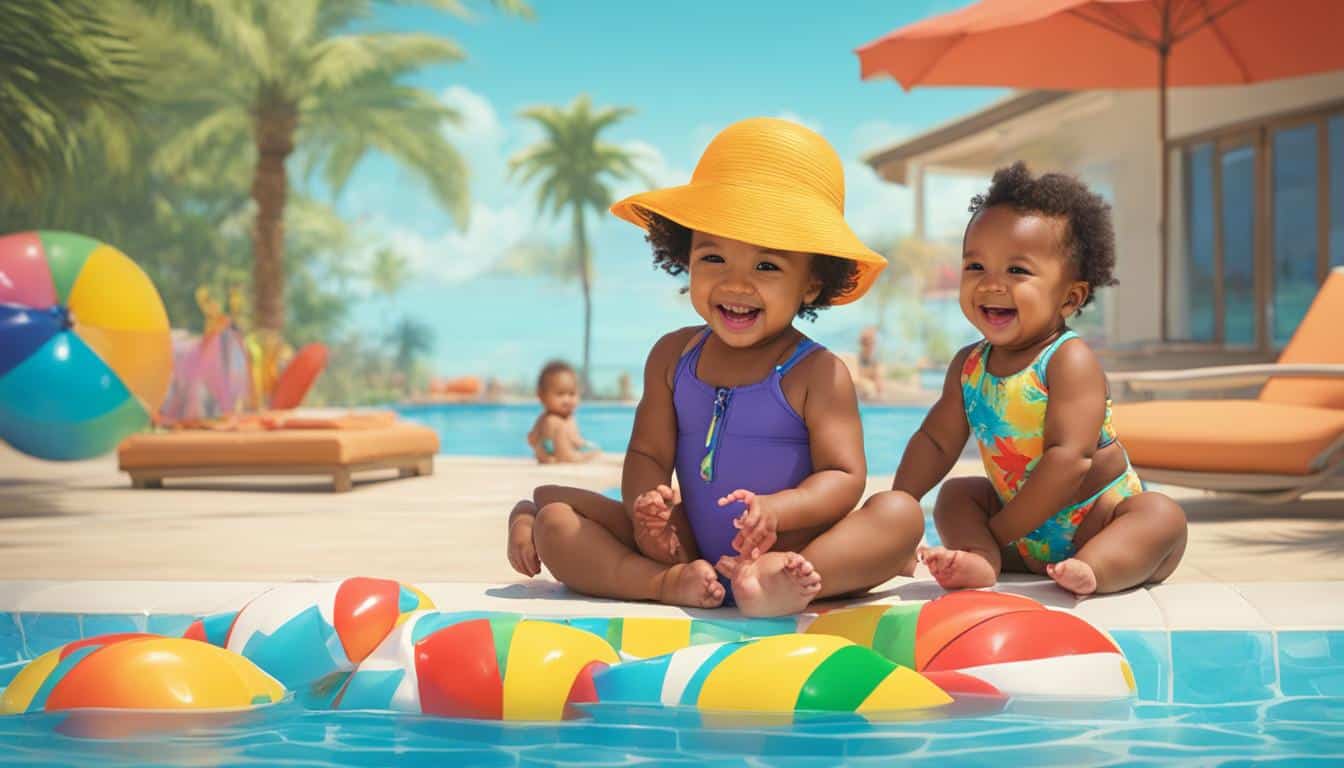Baby’s First Swim: Water Safety and Fun
As a parent, witnessing your baby’s first swim is an exciting milestone that combines water safety with fun and creates lasting memories. Starting early, infants and toddlers from ages 3 months to 3 years can learn essential swimming skills such as buoyancy, propulsion, and breath control. These skills are taught through specialized programs that emphasize parent-child bonding in the water.
With programs like the KIDS FIRST® program, which has trained over 100,000 families, parents can provide their little ones with one-on-one training that focuses on their unique needs and abilities. While infant swim programs offer quality time and skin-to-skin contact, it’s important to note that they do not make children “drown-proof.” Constant supervision is necessary to ensure safety in and around water.
Key Takeaways:
- Starting swim lessons early can help infants and toddlers develop water survival skills.
- Infant swim programs can reduce the risk of drowning for children between 1 and 4 years old.
- When choosing swim lessons, consider qualified instructors and programs that teach water safety habits.
- Ensure safety in the water by closely supervising your baby and following proper water safety measures.
- Even if you can’t swim, you can still enjoy the water with your baby and participate in swim lessons.
Why Start Swim Lessons Early?
Starting swim lessons early offers numerous benefits for infants, toddlers, and babies alike. Research has shown that participating in infant swim programs can reduce the risk of drowning for children between the ages of 1 to 4. These specialized classes focus on developing water survival skills and imparting good water safety habits from a young age.
For infants starting at around 3 months old, swim lessons can help them learn essential swimming skills such as buoyancy, propulsion, and breath control. Parent-child bonding in the water is emphasized in these programs, creating a nurturing environment for both parent and baby to enjoy. By the age of 4, most children are developmentally ready to learn basic water survival skills through swim lessons.
It is important to note that while swim lessons provide valuable learning experiences and quality time in the water, they do not make children “drown proof.” Constant supervision is always necessary to ensure the safety of infants and young children around water.
The Benefits of Early Swim Lessons:
- Reduced risk of drowning for children aged 1 to 4
- Development of essential swimming skills from an early age
- Introduction of good water safety habits
- Parent-child bonding and quality time in the water
“Starting swim lessons early can significantly reduce the risk of drowning for young children while also providing them with important swimming skills and water safety habits.”
While it is important to start swim lessons early, it’s essential to follow the guidelines set by the American Academy of Pediatrics. They do not recommend infant swim classes for babies under 1 year old, as there is currently no evidence that they lower the risk of drowning.
| Age Range | Recommended Swim Lessons |
|---|---|
| 3 months to 1 year | Parent-child bonding classes emphasizing water familiarity |
| 1 year to 4 years | Swim lessons focusing on water survival skills and basic swimming techniques |
Choosing the Right Swim Lessons
When it comes to choosing swim lessons for your baby, there are several important factors to consider. The right swim lessons can help your child develop crucial water safety habits and learn essential swimming skills. Here are some guidelines to help you make the best choice:
Qualified Swim Instructors
One of the key factors to consider is the qualification of the swim instructors. Look for instructors who are trained and certified through a nationally recognized learn-to-swim curriculum. This ensures that they have the knowledge and skills to teach your baby the proper swim stroke techniques and broader water survival competency skills.
Guidelines and Safety Measures
Check if the swim lessons follow specific guidelines and safety measures. Classes should not only focus on developing swimming skills but also teach good safety habits in, on, and near water. These may include skills like never swimming alone and always asking for permission before entering the water. Ensure that the instructors prioritize water safety and provide ongoing feedback on your child’s progress and skill levels.
Small Class Size and Personalized Attention
Consider the class size and the amount of individualized attention your baby will receive. Smaller class sizes allow for more one-on-one interaction between the instructor and your baby, ensuring a more personalized and effective learning experience. This personalized attention is especially important for infants and toddlers who are just starting their swimming journey.
| Factors to Consider when Choosing Swim Lessons | Guidelines for Choosing the Right Swim Lessons |
|---|---|
| Qualified Swim Instructors | Look for instructors trained and certified through a nationally recognized learn-to-swim curriculum. |
| Guidelines and Safety Measures | Choose classes that follow specific guidelines and teach good safety habits in, on, and near water. |
| Small Class Size and Personalized Attention | Consider classes with smaller sizes to ensure more individualized attention for your baby. |
By considering these factors and doing thorough research, you can choose the swim lessons that will provide your baby with a safe and effective learning environment. Remember, the goal is not only to develop swimming skills but also to instill a lifelong love for the water while prioritizing water safety habits.
Safety Measures in the Water
Ensuring the safety of infants and babies in the water is of utmost importance. By following proper safety measures, parents can create a secure environment for their little ones to enjoy swimming. Here are some essential guidelines:
- Supervision: Always supervise your baby closely in the water. Never leave them unattended, even for a moment. Stay within arm’s reach at all times to ensure their safety.
- Hold infants at all times: For infants who cannot sit without support and weigh less than 9kg (20lb), it is crucial to hold them securely when in or near the water. Personal flotation devices or life jackets are not suitable for babies of this size.
- Life jackets for older babies: For babies weighing at least 9kg (20lb), it is recommended that they wear a life jacket or PFD designed and approved for children. This provides added safety when in or near the water.
- Choose the right pool: Select a pool that is heated to a suitable temperature for your baby. Ensure proper chlorination for hygiene purposes. It is also important to check the pool’s safety features, such as fences and gates, to prevent unauthorized access.
“Supervision is key when it comes to water safety for infants and babies. Always keep a watchful eye on your little one, and remember that constant vigilance is necessary.”
Remember that babies lose heat more quickly than adults, so it’s essential to monitor their comfort level in the water. Start with short sessions and gradually increase the time spent swimming. By following these safety measures, parents can ensure a safe and enjoyable swimming experience for their babies.
| Safety Precautions | |
|---|---|
| Supervision | Always supervise your baby closely in the water. Never leave them unattended, even for a moment. Stay within arm’s reach at all times. |
| Hold infants at all times | For infants who cannot sit without support and weigh less than 9kg (20lb), it is crucial to hold them securely when in or near the water. Personal flotation devices or life jackets are not suitable for babies of this size. |
| Life jackets for older babies | For babies weighing at least 9kg (20lb), it is recommended that they wear a life jacket or PFD designed and approved for children. This provides added safety when in or near the water. |
| Choose the right pool | Select a pool that is heated to a suitable temperature for your baby. Ensure proper chlorination for hygiene purposes. Check the pool’s safety features, such as fences and gates, to prevent unauthorized access. |
When Can Babies Start Swimming?
One of the common questions parents have is when babies can start swimming. It is generally recommended to wait until babies are around 4 to 5 months old and can hold their heads up well on their own. This is important to ensure their safety and comfort in the water. Additionally, it is advisable to wait at least seven days after the end of postpartum bleeding before taking babies swimming. If there were interventions or tears during childbirth, it is recommended to wait until after the six-week postpartum check-up. Premature babies or babies with additional needs may have specific recommendations regarding when they can start swimming.
It is crucial to consider the temperature of the water when taking babies swimming. Babies are more sensitive to changes in temperature, so it is important to ensure that the water is warm enough for their comfort. It is also essential to monitor their response to the water and gradually increase the time spent in the pool. By following these guidelines, parents can introduce their babies to swimming at the appropriate age and create a positive and enjoyable experience.
Swimming After Childbirth: Safety First
After giving birth, it is understandable that parents may be eager to start swimming with their babies. However, it is important to prioritize safety and consider the recovery process. It is generally advised to wait until after the postpartum bleeding has ended and to wait for the six-week postpartum check-up before introducing babies to swimming. This allows time for the body to heal and ensures that both the parent and baby are ready for the water. It is always advisable to consult with a healthcare professional to determine the best timeline for swimming after childbirth.
The Benefits of Postpartum Swimming
Postpartum swimming can offer numerous benefits for new parents. It provides an opportunity to engage in low-impact exercise, which can be gentle on the body during the recovery period. Swimming can also help alleviate postpartum symptoms such as muscle aches, stress, and fatigue. Additionally, swimming can promote relaxation, improve sleep quality, and enhance overall well-being. It is important for parents to listen to their bodies and gradually ease into swimming, ensuring that they feel comfortable and safe in the water.
| Ideal Age for Swimming | Postpartum Swimming |
|---|---|
| Recommended to start around 4 to 5 months old | Wait until postpartum bleeding ends and after the six-week postpartum check-up |
| Consider temperature and sensitivity of the baby | Consult with a healthcare professional |
| Gradually increase time in the water | Listen to your body and ease into swimming |
What to Bring to Baby’s Swimming Class
Attending a baby’s swimming class requires some essential items to ensure a comfortable and enjoyable experience for both you and your little one. Here are some things you should bring to your baby’s swimming class:
Swim Diapers
Swim diapers are a must-have to maintain hygiene in the pool. Whether you choose disposable or reusable swim diapers, make sure they fit snugly and securely to prevent any accidents.
Baby Swimming Essentials
- A warm bottle: To provide nourishment for your baby after the swim.
- A soft towel with a hood: This will help keep your baby warm and dry after the swim.
- A snack: If your baby has started solids, pack a small snack to keep them satisfied during the class.
- A few bath toys: These can provide entertainment and stimulation for your baby during playtime in the water.
- A diaper bag: Make sure to bring a diaper bag with all the changing essentials, such as diapers, wipes, and a changing mat.
- A cozy hat: To keep your baby’s head warm after swimming.
Depending on the specific requirements of your baby’s swimming class, there may be additional items suggested by the instructor or facility. It’s always a good idea to check with them beforehand to ensure you have everything you need for a successful and enjoyable swimming session.
| Item | Purpose |
|---|---|
| Swim Diapers | To maintain hygiene in the pool |
| A warm bottle | To provide nourishment for your baby after the swim |
| A soft towel with a hood | To keep your baby warm and dry after the swim |
| A snack | To keep your baby satisfied during the class if they have started solids |
| A few bath toys | To provide entertainment and stimulation for your baby during playtime in the water |
| A diaper bag | To carry all the changing essentials, such as diapers, wipes, and a changing mat |
| A cozy hat | To keep your baby’s head warm after swimming |
By being prepared with these baby swimming essentials, you can ensure a comfortable and enjoyable experience for both you and your little one in the water.
Tips for Taking Your Baby to the Pool
Taking your baby to the pool can be a fun and rewarding experience, but it’s important to prioritize safety and supervision throughout the entire visit. Here are some helpful tips for parents to ensure a safe and enjoyable time in the pool:
1. Get your baby comfortable with water
Prior to heading to the pool, create a positive association with water during bath time. This can help your baby become familiar with the sensation of being in water and reduce any potential anxiety once at the pool.
2. Maintain close supervision
Always hold your baby close and maintain eye contact to establish a sense of security. Even if your baby is wearing a flotation device, never leave them unattended in the pool. Remember, constant supervision is crucial to ensure their safety at all times.
3. Communicate and engage with your baby
Talk to your baby and provide them with words of encouragement and praise throughout the experience. This helps them feel comfortable and builds their confidence in the water. You can also introduce basic water skills, such as blowing bubbles and kicking their legs, as they become more comfortable.
4. Start with short sessions
Begin with short swimming sessions to allow your baby to gradually adjust to the water. Over time, you can increase the duration of the sessions as they become more familiar and comfortable with the pool environment.
Remember, the pool should always be a safe and controlled environment for your baby. By following these tips and maintaining constant supervision, you can create a positive and enjoyable experience while ensuring your baby’s safety in the water.
| Tips for Taking Your Baby to the Pool |
|---|
| Get your baby comfortable with water |
| Maintain close supervision |
| Communicate and engage with your baby |
| Start with short sessions |
Can You Swim with Your Baby Even if You Can’t Swim?
Many parents wonder if they can take their baby swimming even if they can’t swim themselves. The answer is yes! You don’t need to be a proficient swimmer to enjoy the water with your little one. As long as you can walk comfortably in the shallow end of the pool and provide close supervision, you can introduce your baby to the joys of swimming.
However, it is recommended for parents who are non-swimmers to consider attending swimming lessons for adults. Learning basic swimming skills and gaining confidence in the water can enhance your own comfort levels and enable you to better support your baby during swim lessons.
Remember, swimming with your baby is about bonding, water exploration, and creating positive experiences. By following safety guidelines, such as maintaining close supervision and staying in the shallow end, you can both enjoy the water together.
What to Expect in Baby Swimming Classes
Baby swimming classes offer a relaxed and enjoyable environment for both parents and babies. These classes are designed to promote learning through play, helping infants develop water confidence and essential water skills. Here’s what you can expect when attending baby swimming classes:
Engaging Activities
In baby swimming classes, activities are carefully designed to be engaging and age-appropriate. These may include singing nursery rhymes, playing with floating toys, and practicing gentle splashing. The focus is on creating a positive association with the water and encouraging babies to feel comfortable and safe in this new environment.
Learning through Play
Learning through play is a key component of baby swimming classes. By incorporating fun activities and games, infants can develop their motor skills, coordination, and sensory awareness. Classes often provide various props and toys to stimulate their curiosity and create a sense of joy and exploration in the water.
Developing Water Confidence
Baby swimming classes aim to build water confidence in infants. Through gentle movement in the water and positive reinforcement from parents and instructors, babies gradually become more comfortable and relaxed in the aquatic environment. This helps them develop a sense of safety and trust, laying the foundation for future water-related activities.
Water Skills for Infants
Baby swimming classes introduce basic water skills tailored to the developmental stage of each infant. These may include kicking their legs, reaching out for support, and eventually floating on their backs. Each skill is taught gradually and at the baby’s pace, ensuring a positive learning experience. The ultimate goal is to equip infants with important water skills that promote safety and enjoyment in and around water.
| Activity | Description |
|---|---|
| Singing Nursery Rhymes | Parents and instructors sing songs and rhymes to make the learning experience enjoyable and engaging. |
| Playing with Floating Toys | Babies have the opportunity to play with floating toys, encouraging them to reach out and interact with objects in the water. |
| Gentle Splashing | Infants are introduced to gentle splashing, helping them become comfortable with water movement and sensory stimulation. |
Finding Baby Swimming Lessons
When it comes to finding baby swimming lessons, there are various options available to parents. Local swimming pools often offer specific classes or sessions designed for parents and babies to participate in together. These classes provide a great opportunity for babies to become familiar with the water in a safe and controlled environment while also allowing parents to bond with their little ones. Additionally, there are organizations and websites that specialize in baby swim programs, offering a wide range of swimming courses specifically tailored for infants and toddlers.
Some popular resources for locating baby swim lessons include Aqua-Tots, Red Cross, Water Babies, YMCA, and Pedalheads. These organizations offer comprehensive programs that focus on water safety and skill development for babies. By visiting their websites or contacting their local branches, parents can gather information about program availability, schedules, and registration procedures. It is important to research and choose a program that aligns with your baby’s age, developmental stage, and your own expectations.
For those who prefer the convenience and flexibility of online resources, there are also websites that provide baby swim lessons. These online platforms offer instructional videos, step-by-step guides, and interactive activities that can be accessed from the comfort of your own home. While virtual lessons may lack the in-person interaction and immediate feedback of traditional classes, they can still be a valuable resource for parents who are unable to attend physical swim sessions or prefer to learn at their own pace.
Comparing Baby Swim Lesson Resources
To help you make an informed decision, here is a table comparing some popular baby swim lesson resources:
| Resource | Program Features | Availability | Cost |
|---|---|---|---|
| Aqua-Tots | Small class sizes, experienced instructors, comprehensive curriculum | Multiple locations across the United States | Varies depending on location and program |
| Red Cross | Structured lessons, focus on water safety, certified instructors | Wide network of local chapters | Varies depending on location and program |
| Water Babies | Parent and baby classes, gentle introduction to water, progressive skill development | Various locations worldwide | Varies depending on location and program |
| YMCA | Group classes, water safety education, inclusive environment | Local branches in many communities | Membership fees or class fees |
| Pedalheads | Swim programs for infants and toddlers, focus on water confidence and skill development | Available in select cities across the United States and Canada | Varies depending on location and program |
It’s important to note that the cost, availability, and program features may vary depending on the location and specific offerings of each resource. Take the time to research and compare the options available in your area to find the best fit for you and your baby’s needs.
Water Safety and Beyond: Conclusion
In conclusion, baby’s first swim is an important milestone that combines water safety with fun. Starting swim lessons early not only introduces infants and toddlers to essential swimming skills but also helps reduce the risk of drowning. However, it’s crucial to remember that swim lessons do not make children “drown proof,” and constant supervision is necessary to ensure their safety.
By choosing the right swim lessons and qualified instructors, parents can provide their babies with a safe and enjoyable learning experience. It’s essential to follow guidelines that focus on both swim stroke techniques and water survival competency skills. Additionally, ensuring safety measures in the water, such as proper supervision and appropriate pool conditions, is crucial to creating a secure environment for babies to swim.
Water safety goes beyond swim lessons. It is a lifelong skill and responsibility. Nurturing a love for swimming in babies can create lasting memories and promote a healthy relationship with water. By instilling good water safety habits from an early age, parents can help their children develop confidence in the water while prioritizing their safety.
In conclusion, baby’s first swim is an exciting journey that requires careful consideration of water safety. By providing infants and toddlers with the right swim lessons, constant supervision, and a nurturing environment, parents can ensure their child’s enjoyment and safety in the water for years to come.
FAQ
Why is it important to start swim lessons early for babies?
Starting swim lessons early helps babies develop essential swimming skills and introduces good water safety habits from a young age.
How can I choose the right swim lessons for my baby?
When choosing swim lessons, consider factors such as instructor qualifications, curriculum focus, safety guidelines, and ongoing feedback.
What safety measures should I take when introducing my baby to swimming?
It is important to supervise babies closely in the water, maintain proper water temperature and chlorination, and ensure appropriate flotation devices.
When can babies start swimming?
Most pediatricians suggest waiting until babies are around 4 to 5 months old and able to hold their heads up well on their own before introducing them to swimming.
What should I bring to my baby’s swimming class?
Essential items to bring include swim diapers, a warm bottle for after the swim, a soft towel with a hood, bath toys, a diaper bag with essentials, and a cozy hat.
What tips can you provide for taking a baby to the pool?
Get your baby comfortable with water during bath time, maintain eye contact, communicate with your baby, introduce basic water skills, start with short sessions, and prioritize supervision.
Can I take my baby swimming if I can’t swim myself?
Yes, as long as you can walk with your baby in the shallow end of the pool. It can be helpful for non-swimming parents to attend swimming lessons for adults to gain confidence in the water.
What should I expect in baby swimming classes?
Baby swimming classes are designed to be relaxed and fun, focusing on building water confidence and introducing basic water skills through play.
How can I find baby swimming lessons in my area?
Look for local pools, organizations, and websites that offer baby swim lessons. Some popular options include Aqua-Tots, Red Cross, Water Babies, YMCA, and Pedalheads.
Why is water safety important beyond baby swimming lessons?
Water safety is crucial throughout a child’s development and beyond. Nurturing a love for swimming while prioritizing safety ensures a positive and enjoyable water experience.






